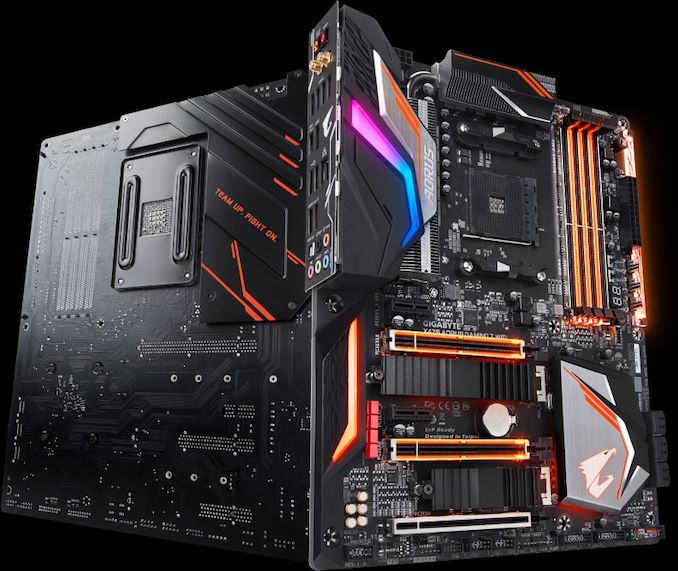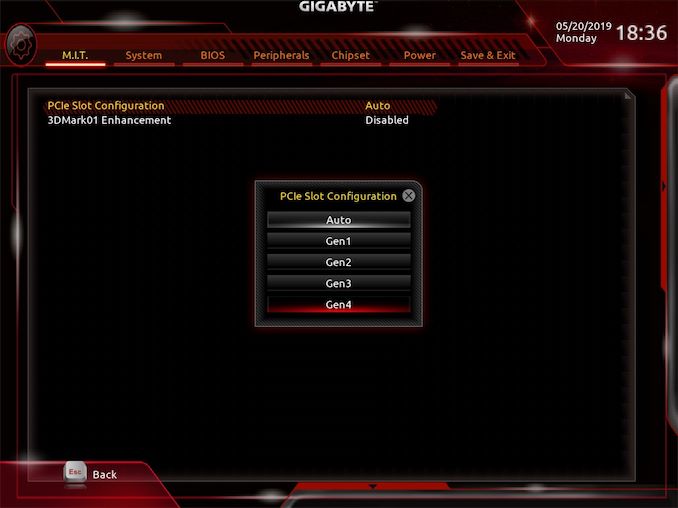GIGABYTE AM4 Motherboards: PCIe 4.0 Ready for Ryzen 3000
by Gavin Bonshor on May 21, 2019 11:00 AM EST
In preparation for the launch of AMD's next generation of Ryzen processors, GIGABYTE has released a wave of firmware updates for its X470 and B450 AM4 socket motherboards. The new firmware adds listed support for AMD's Ryzen 3000 series (Matisse) processors prior to launch.
GIGABYTE has launched its own firmware updates offering users support AMD's upcoming Ryzen 3000 series processors. This not only means users can use their existing AM4 motherboards with the upcoming CPUs when they launch later this year, but upon some investigation with a GIGABYTE X470 Gaming 7 Wi-Fi motherboard we had in the lab, I flashed it to the latest F40 firmware update, and found that PCIe 4.0 could be set within the PCIe slot configurator.
 GIGABYTE X470 Gaming 7 Wi-Fi running the latest F40 firmware confirms some PCIe 4.0 support
GIGABYTE X470 Gaming 7 Wi-Fi running the latest F40 firmware confirms some PCIe 4.0 support
While there is no official confirmation from GIGABYTE itself (or from any of the other vendors for that fact), PCIe 4.0 support on current generation AM4 motherboards will be done on a model by model basis. Back at CES 2019, we confirmed that AMD's 3000 series CPUs would become the world's first mainstream CPU to support PCIe 4.0 x16. However, PCIe 4.0 support on current motherboards in the market will depend on how they are built: PCIe 4.0 specifications state that traces should be under a minimum length, and any longer requires a PCIe 4.0 redriver to boost the signal further down the board. Due to this, it is probable, but not confirmed that some existing X370, B350, X470 and B450 models may not offer the full capacity of PCIe 4.0 that Ryzen 3000 is expected to see when it is launched in the coming months.
As there is a lot of speculation around AMD's Ryzen 3000 series, X570, and which current generation AM4 motherboards will support the new PCIe 4.0 interface, it's clear that it will feature in some capacity. In what capacity exactly is currently unknown. Given the limitations, PCIe 4.0 might be limited to the top slot on most motherboards. Without existing redrivers on the lower located slots of ATX sized AM4 models, it wouldn't actually be possible to benefit from PCIe 4.0 with the distance restriction in play for an effective signal. This would mean that the top slot could operate at PCIe 4.0, whereas each of the other slots below would be locked down to PCIe 3.0 by default. Obviously new X570 boards will be built with this in mind.
The wave of F40 firmware updates can be downloaded from the relative product pages of each of the current GIGABYTE B450 and X470 models. GIGABYTE has also made us aware that we can expect similar firmware updates for its B350 and X370 models at the end of the month.
Related Reading
- The GIGABYTE X470 Gaming 7 Wi-Fi Motherboard Review: The AM4 Aorus Flagship
- AMD Ryzen 3rd Gen 'Matisse' Coming Mid 2019: Eight Core Zen 2 with PCIe 4.0 on Desktop
- AMD Reiterates 7nm Roadmap: Navi, Matisse, & Rome to Launch in Q3
- AMD to Host "Next Horizon Gaming" Event & Product Unveil at E3 2019: June 10th, 3pm PT
- Analyzing B450 for AMD Ryzen: A Quick Look at 25+ Motherboards
Source: GIGABYTE










32 Comments
View All Comments
HStewart - Wednesday, May 22, 2019 - link
Why do people assume that - because they are bias themselves. This would not matter who comes out with it.In some ways this was a test for your bias peoplewho think if people like Intel, they are bias against. anything else. This attitude honestly is why I will never pick a non Intel product - assuming it Windows based - this includes the slow Windows for ARM's, But I have a Galaxy Tab S3 and Galaxy Note 8 which I love.
I even try an AMD derived GPU in my Dell XPS 15 2in1
Biggest thing I hate about AMD fans is they keep trying to push makers to come out with AMD based notebook - but do any of them actually buy them have desktops. Maybe some people have them also - but my guess is NO.
I normally would stay out of desktop cpu discussions, because I believe as CPU's becomes more and more efficient and use less power - cpu makers will drop the difference and desktops will have same cpus as laptops.
Lord of the Bored - Wednesday, May 22, 2019 - link
All I have to say is ROFLKorguz - Wednesday, May 22, 2019 - link
you are one to talk Hstewart... calling people on here bias.. when you, yourself.. are blatantly pro-intel, 90% of your comments.. show this FACT. im not biased against intel, OR amd.. but right now.. AMD has more interesting products coming out then your beloved intel for the last like 5 years... not to mention the ongoing promise about 10nm products being released.. " This attitude honestly is why I will never pick a non Intel product" no.. you will ONLY buy intel.. cause to you.. intel is the god of the cpu.. and there is nothing else out there... nice try.. but blaming those that like amd over your beloved intel, is not a reason..." Biggest thing I hate about AMD fans is they keep trying to push makers to come out with AMD based notebook - but do any of them actually buy them have desktops. Maybe some people have them also - but my guess is NO." for me at least.. this whole quote, is WRONG. i have 2 AMD based notebooks, i have 6 comps currently topgether in my house.. 4 are intel based, 2 are AMD... so nice try with that assumption.
sa666666 - Wednesday, May 22, 2019 - link
> In some ways this was a test for your bias peoplewho think if people like Intel, they are bias against. anything else. This attitude honestly is why I will never pick a non Intel productSo in other words you're clearly (and admittedly) trolling? That is, posting something in such a way as to instigate an argument (aka, trolling)??
Qasar - Wednesday, May 22, 2019 - link
um sa666666, from what i have seen on here.. thats exactly what HStewart does.. and that is his ONLY intent.. is to troll.. although his posts, and replies from others to his posts, can be quite entertaining... HStewart is getting a little long in the tooth on here....Reflex - Tuesday, May 21, 2019 - link
This has not been an issue the PCIe spec has had, PCIe2 & 3 devices were always fully backwards and forwards compatible, there is little reason to expect different for PCIe4 & 5.cfineman - Tuesday, May 21, 2019 - link
I too would expect that level of comptibility. As far as what PCI 4 means on these boards... I had assumed it would just allow for more lanes to be used thus improving bandwidth for the entire system but not throughput for a particular component. Am I off base here? A GPU could get its firmware upgraded but would it be able to exploit higher throughput?Am I thinking about this incorrectly?(obviously this is not my area of expertise)
GreenReaper - Tuesday, May 21, 2019 - link
Increased throughput comes from more being transferred with an *existing* number of lanes.Think of each lane as a road (or better, a rail line). It's possible to configure a lane to accommodate specially-designed vehicles which move at twice the speed (or are double-decker, or a mix of the two). Those designed for looser tolerances remain in a separate lane at the previous speed. Of course this only works if the road/rail is sturdy enough - if it was marginal to begin with, it may crumble under the increased traffic.
The main reason some motherboards may support PCIe 4.0 is that their involvement is relatively simple - providing a flat wire between two components. It's the components at the ends that are complicated - in this case, the CPU and the GPU.
A GPU can only exploit higher speeds if its software *and* hardware is capable - so it's unlikely that we'll see such upgrades in software. You'll need a new GPU, designed for PCIe 4.0, although it'll work with any version - just maybe not quite as fast.
Likewise, where a motherboard's involvement is greater than a wire (i.e. multi-function bridge chips), there will be no improvement; it'll run at the same speed, and any peripherals behind the bridge will be limited to existing speeds, too.
(In a similar way, Category 5e Ethernet cables can be used to push 2.5 Gbps or even 5 Gbps, rather than the original 1 Gbps; but that doesn't mean your old Ethernet router can now run at 5 Gbps. There are new error-correction encodings, protocols, clocks need to be faster, etc.
On the plus side, if you use PCIe 4.0, you halve the number of lanes needed to support an Ethernet transciever, which may help increase the number of 2.5 Gbps or 5 Gbps ports...)
Santoval - Wednesday, May 22, 2019 - link
"Am I off base here?... Am I thinking about this incorrectly?"Short and long answer : yes. PCIe 4.0 will allow the exact opposite of that, just as happened with the transition from PCIe 2.0 to 3.0. Instead of requiring more PCIe lanes for more I/O bandwidth it can allow double the bandwidth -either to individual devices, to the entire system or both- with the same number of lanes.
Alternatively it can provide the same bandwidth with half the number of lanes, four times the bandwidth with double the lanes -an extreme and implausible example- or anything between the above "pairs" (such as three times the bandwidth with +50% more lanes).
Santoval - Wednesday, May 22, 2019 - link
It will 100% be backwards compatible with PCIe 3.0, because devices/slot adhering to the PCIe spec are extensively tested for backwards compatibility of at least one PCIe generation. The backwards compatibility with PCIe 2.0 will of course be less clear and probably not guaranteed.